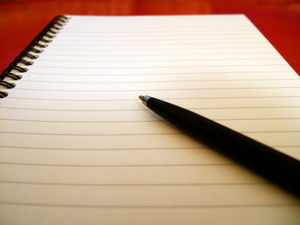Scritch Scratch. Squiggle Scratch. Scritch Scratch. Bang. This is the sound of you, a devoted college student, trying to write a term paper. It’s not going well, is it? Write, erase, write, bang your head on the wall. You’re getting nowhere, and it’s due in two days. You’ll get it done; you always do. But you nearly drown in disgust each time. There is a better way.
1. Drink plenty of cold water before you sit down to start the paper. It will give your body a rush and wake it up, while at the same time hydrating your brain. If nothing else, it will give you an excuse to take a bathroom break. DON’T, however, drink a can of soda! The caffeine, rejuvenating as it may sound, is detrimental to your thinking skills, and the sugar content causes your blood to race and your brain to slug, causing you to feel hyper and, well, brainless.
2. Begin with two sheets of lined paper and a pen. Not a pencil. You’ll spend too much time erasing with a pencil, and less time thinking. If you want to scratch something out, you can do it just as easily with a pen.
3. Take one sheet of paper and jot down all the key elements you can think of off the top of your head; don’t check your notes or books. Use your memory. Skip lines between each element so you can add to it if necessary.
4. I hereby give you permission to consult your notes and books for more pointers. A little Internet research goes a long way, too. When trying to find topics online, try to use specifics in the search. Narrowing the field of the search engines can save you lots of time sorting through links. Don’t just type in “American Literature” when you really want to research more about Nathaniel Hawthorne. Keep in mind that encyclopedia references aren’t highly looked upon; use Britannica and Wikipedia as little as possible. Be sure to bookmark all of the links you find and wish to use in a folder called “Essay links” for use in referencing the proper authors when bibliography time rolls around.
5. In the margins, mark each element in order of importance from one to ten, or twenty, or thirty. One of the keys to writing a successful paper is leaving the most important, earth-shattering part until the end of the essay. It gives readers something to look forward to.
6. You know all those outlines you were tormented with in high school? Recall them to life, because you’re going to need them again. Despicable as they are, an outline is crucial to organizing your thoughts and ensuring that you have included all the necessary points. List the most important points in the heading sections, and group similar elements in the subheadings. The key here is to align similar topics together. Most college professors like to see two major headings, at the very least, with plenty of subsequent topics below. The more detailed, the better. Pudgy outlines often reap smiles on the faces of the college egotist in charge.
7. Now that your thoughts are all organized (yeah right), begin writing the preliminary sentences. By preliminary, I don’t mean that you must start with the introductory paragraph, but rather whichever topic is tripping your trigger at the moment. It’s easiest to begin a paragraph about the subtopic of your choice, or that which you know the most about. This way, you’ll get on a roll, and the words will keep flowing even when you reach the more difficult stuff.
8. Each time you finish a section on the outline, check it off. This will give you a sense of completion. If you’re having a hard time motivating yourself for the next paragraph, get up, walk a few paces around the room, clear your mind just a bit, and sit back down. Get a bite to eat if your stomach is growling; distractions like this don’t produce good papers. But don’t dally. Your brain is still ruminating your subject, so you’ll want to keep the thought juices flowing. If you need more inspiration, plug in your favorite kind of music – softly. Your brain cycle will change a little bit, causing you to look at your subject in a different light, thus producing a more rounded out project.
9. I’ve heard from various resources that one of the best ways to get your point across in a paper is to tell the people what you’re going to tell them, then tell them, and finally tell them what you told them. This is perhaps a little cut and dried, but the model fits. If you left your introductory and conclusion paragraphs to the end, let’s tackle them this way. The thesis statement needs to be a strong one, so choose at least three main points your paper has covered and list them in the statement in the order in which they occur. For the conclusion statement, the same thing can apply, but in a different fashion. Oftentimes you can leave the reader with a challenge, or by daring them to entertain a different viewpoint. If you’ve had one punch of a statement in mind, here’s the place to put it.
10. You’re almost done! Now for the little details. Make sure no one else gets credit for your hard work by putting your last name next to the page number of each page, separated with a dash, of course. This can be accomplished by editing the Header/Footer section of a program like Word. Choose a title based upon the theme of your subject; I like to choose titles that make the reader do a double take. It needs to fit with the paper, yet stand out like an orange in a basket of apples. And don’t forget to give credit to your sources; in the bibliography or works cited section, document all applicable sources.
As a last word of advice, don’t fret. Life goes on after those college papers, and in a month you won’t even remember all the heartache you went through to get it done. That is, until you have to do it again.




